Deck 15: Multinationals and Migration: International Factor Movements
Question
Question
Question
Question
Question
Question
Question
Question
Question
Question
Question
Question
Question
Question
Question
Question
Question
Question
Question
Question
Question
Question
Question
Question
Question
Question
Question
Question
Question
Question
Question
Question
Question
Question
Question
Question
Question
Question
Question
Question
Question
Question
Question
Question
Question
Question
Question
Question
Question
Question
Question
Question
Question
Question
Question
Question
Question
Question
Question
Question

Unlock Deck
Sign up to unlock the cards in this deck!
Unlock Deck
Unlock Deck
1/60
Play
Full screen (f)
Deck 15: Multinationals and Migration: International Factor Movements
1
Financing from the parent company to its foreign affiliates is generally a small percentage of total funding because:
A)the returns on such investment are taxed at very high rates.
B)the parent firm wants to reduce the risks to which its foreign activities are exposed.
C)most foreign governments have imposed quotas of foreign investment in their domestic economy.
D)most major home-country governments limit investment in foreign firms by their domestic firms.
A)the returns on such investment are taxed at very high rates.
B)the parent firm wants to reduce the risks to which its foreign activities are exposed.
C)most foreign governments have imposed quotas of foreign investment in their domestic economy.
D)most major home-country governments limit investment in foreign firms by their domestic firms.
B
2
Which of the following refers to transfer pricing by an MNE?
A)The act of buying a good at a low price and selling it at a high price
B)The process of setting a high price for a good in a market with relatively inelastic demand and setting a low price in a market with relatively elastic demand
C)Lowering the product prices to undercut the competitors and gain a greater market share
D)Setting prices by the company for things that move between the units of the company
A)The act of buying a good at a low price and selling it at a high price
B)The process of setting a high price for a good in a market with relatively inelastic demand and setting a low price in a market with relatively elastic demand
C)Lowering the product prices to undercut the competitors and gain a greater market share
D)Setting prices by the company for things that move between the units of the company
D
3
Which of the following is an example of Foreign Direct Investment?
A)Ford motor company puts $10 million from its pension fund into a mutual fund containing shares of foreign companies.
B)Dr.Gareau, a French biologist, buys $5,000 worth of shares of Toyota.
C)Wells Fargo Bank buys $10 million worth of Bank of England T-Bills.
D)Ford buys a controlling interest in Land Rover, a British automobile company.
A)Ford motor company puts $10 million from its pension fund into a mutual fund containing shares of foreign companies.
B)Dr.Gareau, a French biologist, buys $5,000 worth of shares of Toyota.
C)Wells Fargo Bank buys $10 million worth of Bank of England T-Bills.
D)Ford buys a controlling interest in Land Rover, a British automobile company.
D
4
Most foreign direct investment is in:
A)the agricultural sector.
B)the manufacturing sector.
C)the mining and extraction sector.
D)the service sector.
A)the agricultural sector.
B)the manufacturing sector.
C)the mining and extraction sector.
D)the service sector.

Unlock Deck
Unlock for access to all 60 flashcards in this deck.
Unlock Deck
k this deck
5
How can an MNE overcome its inherent disadvantages?
A)By borrowing funds from the host country rather than transferring funds from the parent firm
B)By producing more than two products in which it has comparative advantage
C)By expanding its operation in more than two host countries
D)By owning one or more assets that are not owned by its local competitors in the host country
A)By borrowing funds from the host country rather than transferring funds from the parent firm
B)By producing more than two products in which it has comparative advantage
C)By expanding its operation in more than two host countries
D)By owning one or more assets that are not owned by its local competitors in the host country

Unlock Deck
Unlock for access to all 60 flashcards in this deck.
Unlock Deck
k this deck
6
Foreign Direct Investment (FDI) refers to:
A)the flow of funding provided by an investor or lender to establish or acquire a foreign company or to expand or finance an existing foreign company that the investor owns and controls.
B)the hot money that an investor needs to get registered in a foreign stock exchange to make investments, and have the liberty to sell and take back the stocks purchased earlier.
C)a method of funding business adopted by a foreign investor by participating directly in the secondary markets of a country, through investments in the country's stocks or bonds.
D)the passive holding of securities such as foreign stocks, bonds, or other financial assets, none of which entails active management or control of the securities issued by the investor.
A)the flow of funding provided by an investor or lender to establish or acquire a foreign company or to expand or finance an existing foreign company that the investor owns and controls.
B)the hot money that an investor needs to get registered in a foreign stock exchange to make investments, and have the liberty to sell and take back the stocks purchased earlier.
C)a method of funding business adopted by a foreign investor by participating directly in the secondary markets of a country, through investments in the country's stocks or bonds.
D)the passive holding of securities such as foreign stocks, bonds, or other financial assets, none of which entails active management or control of the securities issued by the investor.

Unlock Deck
Unlock for access to all 60 flashcards in this deck.
Unlock Deck
k this deck
7
Multinationals typically operate in a market structure that would best be described as:
A)an oligopoly.
B)perfect competition.
C)inherently disadvantaged.
D)monopoly.
A)an oligopoly.
B)perfect competition.
C)inherently disadvantaged.
D)monopoly.

Unlock Deck
Unlock for access to all 60 flashcards in this deck.
Unlock Deck
k this deck
8
Which of the following provides a good explanation of why multinational firms exist?
A)Location factors that favor exporting over foreign production
B)The need to shift financial capital between countries
C)Internalization advantages that favor direct investment over contracting with independent foreign firms
D)Firms lack inherent knowledge of foreign laws, procedures, and practices.
A)Location factors that favor exporting over foreign production
B)The need to shift financial capital between countries
C)Internalization advantages that favor direct investment over contracting with independent foreign firms
D)Firms lack inherent knowledge of foreign laws, procedures, and practices.

Unlock Deck
Unlock for access to all 60 flashcards in this deck.
Unlock Deck
k this deck
9
Import tariffs and non-tariff barriers suggest that:
A)FDI is a substitute for exporting.
B)exporting is preferable to FDI.
C)exporting is preferable to licensing local firms in the foreign markets.
D)such measures restrict the ability of MNEs' to expand their operations.
A)FDI is a substitute for exporting.
B)exporting is preferable to FDI.
C)exporting is preferable to licensing local firms in the foreign markets.
D)such measures restrict the ability of MNEs' to expand their operations.

Unlock Deck
Unlock for access to all 60 flashcards in this deck.
Unlock Deck
k this deck
10
A firm that owns and controls operations in more than one country is a(n):
A)franchise.
B)MNE.
C)monopolist.
D)affiliate.
A)franchise.
B)MNE.
C)monopolist.
D)affiliate.

Unlock Deck
Unlock for access to all 60 flashcards in this deck.
Unlock Deck
k this deck
11
Which of the following ways can an MNE adopt to reduce its exposure to political risks in its host country?
A)By threatening to cease all exports of its products to the host country
B)By establishing more than one affiliate in the host country
C)By equating its physical assets in the host country with its local borrowings
D)By negotiating with the host country's government to clear off its debts
A)By threatening to cease all exports of its products to the host country
B)By establishing more than one affiliate in the host country
C)By equating its physical assets in the host country with its local borrowings
D)By negotiating with the host country's government to clear off its debts

Unlock Deck
Unlock for access to all 60 flashcards in this deck.
Unlock Deck
k this deck
12
As long as _____ and _____ are low enough, foreign direct investment can be used to reduce total costs by locating different stages of overall production in different countries.
A)foreign demand; transport costs
B)transport costs; trade barriers
C)trade barriers; domestic demand
D)domestic taxes; foreign demand
A)foreign demand; transport costs
B)transport costs; trade barriers
C)trade barriers; domestic demand
D)domestic taxes; foreign demand

Unlock Deck
Unlock for access to all 60 flashcards in this deck.
Unlock Deck
k this deck
13
Which of the following is NOT a firm specific advantage of an MNE?
A)Patented technology
B)Marketing capabilities
C)Superior management technique
D)Native understanding of local customs
A)Patented technology
B)Marketing capabilities
C)Superior management technique
D)Native understanding of local customs

Unlock Deck
Unlock for access to all 60 flashcards in this deck.
Unlock Deck
k this deck
14
Which of the following statements is true concerning the global flow of FDI since 1990?
A)The proportion of global FDI that flowed into developing countries increased.
B)Mexico has received more FDI inflows than has the United States.
C)The proportion of global FDI that flowed into the United States increased.
D)FDI flows into the European Union fell.
A)The proportion of global FDI that flowed into developing countries increased.
B)Mexico has received more FDI inflows than has the United States.
C)The proportion of global FDI that flowed into the United States increased.
D)FDI flows into the European Union fell.

Unlock Deck
Unlock for access to all 60 flashcards in this deck.
Unlock Deck
k this deck
15
Which of the following is true for a multinational enterprise (MNE)?
A)Its affiliates usually get nearly all of their total financing from the direct investment flows.
B)It usually transfers its liabilities to its foreign subsidiaries.
C)Its domestic tax burden is mostly borne by its foreign affiliates.
D)It usually provides intangible assets to its affiliates for their usage.
A)Its affiliates usually get nearly all of their total financing from the direct investment flows.
B)It usually transfers its liabilities to its foreign subsidiaries.
C)Its domestic tax burden is mostly borne by its foreign affiliates.
D)It usually provides intangible assets to its affiliates for their usage.

Unlock Deck
Unlock for access to all 60 flashcards in this deck.
Unlock Deck
k this deck
16
Which of the following is an inherent disadvantage to being a multinational enterprise?
A)An MNE does not initially have the native understanding of local laws, customs, procedures, practices, and relationships.
B)An MNE does not have the same assets as those held by its local competitors in the host market.
C)An MNE does not enjoy comparative advantages in the same goods as those of its local competitors in the host market.
D)An MNE's profits are doubly taxed by two governments.
A)An MNE does not initially have the native understanding of local laws, customs, procedures, practices, and relationships.
B)An MNE does not have the same assets as those held by its local competitors in the host market.
C)An MNE does not enjoy comparative advantages in the same goods as those of its local competitors in the host market.
D)An MNE's profits are doubly taxed by two governments.

Unlock Deck
Unlock for access to all 60 flashcards in this deck.
Unlock Deck
k this deck
17
At the end of 2011, most of the United States' foreign direct investment was in:
A)the other NAFTA countries.
B)the developing countries in Asia.
C)the European Union countries.
D)the Latin American countries.
A)the other NAFTA countries.
B)the developing countries in Asia.
C)the European Union countries.
D)the Latin American countries.

Unlock Deck
Unlock for access to all 60 flashcards in this deck.
Unlock Deck
k this deck
18
Multinational enterprises use transfer pricing to:
A)lower prices of their products and gain market share.
B)reduce their global tax burden.
C)move products to the markets where the demand for those goods is relatively inelastic.
D)provide managers in a foreign affiliate with an incentive to maximize local profit.
A)lower prices of their products and gain market share.
B)reduce their global tax burden.
C)move products to the markets where the demand for those goods is relatively inelastic.
D)provide managers in a foreign affiliate with an incentive to maximize local profit.

Unlock Deck
Unlock for access to all 60 flashcards in this deck.
Unlock Deck
k this deck
19
The existence of economies of scale suggests that:
A)FDI is a complement to exporting.
B)exporting can be preferable to FDI.
C)licensing local firms in the foreign market is preferable to exporting.
D)inherent disadvantages cannot be fully overcome.
A)FDI is a complement to exporting.
B)exporting can be preferable to FDI.
C)licensing local firms in the foreign market is preferable to exporting.
D)inherent disadvantages cannot be fully overcome.

Unlock Deck
Unlock for access to all 60 flashcards in this deck.
Unlock Deck
k this deck
20
Concern about the ability of independent foreign firms to maintain product quality:
A)often results in the formation of a license agreement between a foreign firm and an MNE.
B)makes licensing firms in the foreign markets preferable to FDI.
C)is an inherent disadvantage faced by the multinationals.
D)makes FDI preferable to licensing firms in the foreign markets.
A)often results in the formation of a license agreement between a foreign firm and an MNE.
B)makes licensing firms in the foreign markets preferable to FDI.
C)is an inherent disadvantage faced by the multinationals.
D)makes FDI preferable to licensing firms in the foreign markets.

Unlock Deck
Unlock for access to all 60 flashcards in this deck.
Unlock Deck
k this deck
21
The figure given below represents the effects in the labor markets due to migration. Here the world has been divided into a high-income "North" (left panel) and a low-income "South" (right panel). Dn and Sn are the labor demand and the labor supply curves in North. Ds and (Sr + Smig) are the labor demand and pre-migration labor supply curves in South. Sr is the post-migration labor supply curve in South. The value c is the cost of migrating. 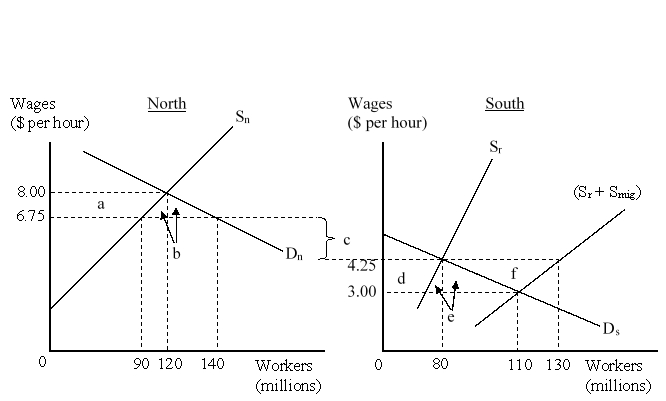 The net gain to the migrants is represented by the area:
The net gain to the migrants is represented by the area:
A)(a + b).
B)(e + f).
C)(d + e).
D)(a + f).
 The net gain to the migrants is represented by the area:
The net gain to the migrants is represented by the area:A)(a + b).
B)(e + f).
C)(d + e).
D)(a + f).

Unlock Deck
Unlock for access to all 60 flashcards in this deck.
Unlock Deck
k this deck
22
One measure that would compensate the sending country for its public investments in emigrants could be a(n):
A)tax on sending-country product exports.
B)subsidy to sending-country product imports.
C)brain-drain tax.
D)tax on sending-country affiliates of foreign MNEs.
A)tax on sending-country product exports.
B)subsidy to sending-country product imports.
C)brain-drain tax.
D)tax on sending-country affiliates of foreign MNEs.

Unlock Deck
Unlock for access to all 60 flashcards in this deck.
Unlock Deck
k this deck
23
_____ is the movement of people from one country to another country in which they plan to reside for some noticeable period of time.
A)Denationalization
B)International transfer
C)Internal migration
D)International migration
A)Denationalization
B)International transfer
C)Internal migration
D)International migration

Unlock Deck
Unlock for access to all 60 flashcards in this deck.
Unlock Deck
k this deck
24
The figure given below represents the effects in the labor markets due to migration. Here the world has been divided into a high-income "North" (left panel) and a low-income "South" (right panel). Dn and Sn are the labor demand and the labor supply curves in North. Ds and (Sr + Smig) are the labor demand and pre-migration labor supply curves in South. Sr is the post-migration labor supply curve in South. The value c is the cost of migrating. 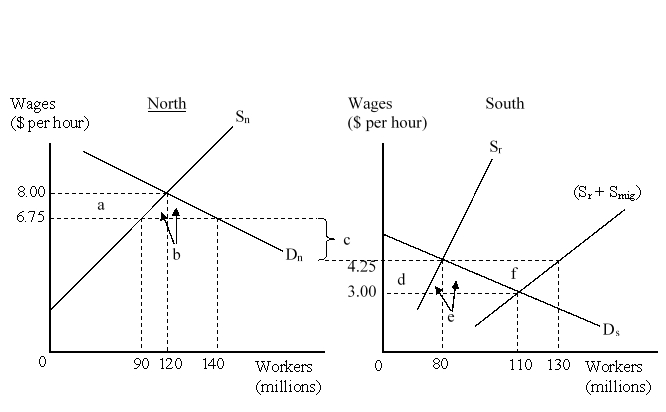 The migration cost on a per hour basis is:
The migration cost on a per hour basis is:
A)$4.25.
B)$6.75.
C)$2.50.
D)$3.00.
 The migration cost on a per hour basis is:
The migration cost on a per hour basis is:A)$4.25.
B)$6.75.
C)$2.50.
D)$3.00.

Unlock Deck
Unlock for access to all 60 flashcards in this deck.
Unlock Deck
k this deck
25
Which of the following is true of FDI in China?
A)FDI inflows in China declined substantially during 2007-2009.
B)Three-fifths of the FDI into China is in the service sector.
C)Much of China's FDI has come from the developing countries located close to it.
D)Foreign affiliated firms account for more than 50 percent of production value added in China.
A)FDI inflows in China declined substantially during 2007-2009.
B)Three-fifths of the FDI into China is in the service sector.
C)Much of China's FDI has come from the developing countries located close to it.
D)Foreign affiliated firms account for more than 50 percent of production value added in China.

Unlock Deck
Unlock for access to all 60 flashcards in this deck.
Unlock Deck
k this deck
26
The figure given below represents the effects in the labor markets due to migration. Here the world has been divided into a high-income "North" (left panel) and a low-income "South" (right panel). Dn and Sn are the labor demand and the labor supply curves in North. Ds and (Sr + Smig) are the labor demand and pre-migration labor supply curves in South. Sr is the post-migration labor supply curve in South. The value c is the cost of migrating. 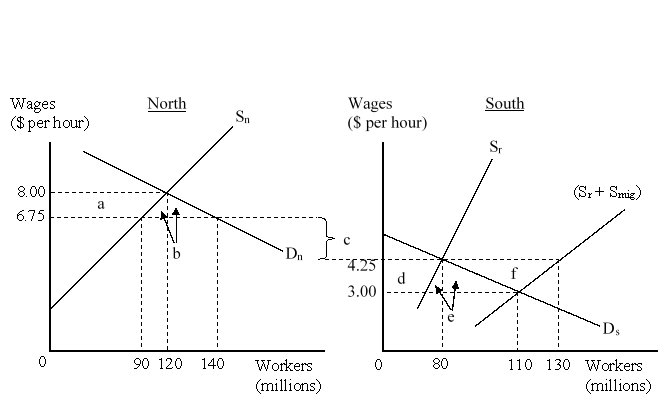 After the migration, the native employees in North:
After the migration, the native employees in North:
A)lose welfare given by area 'a'.
B)gain welfare given by area (a+b).
C)lose welfare given by area (a+b).
D)lose welfare given by area (e + f).
 After the migration, the native employees in North:
After the migration, the native employees in North:A)lose welfare given by area 'a'.
B)gain welfare given by area (a+b).
C)lose welfare given by area (a+b).
D)lose welfare given by area (e + f).

Unlock Deck
Unlock for access to all 60 flashcards in this deck.
Unlock Deck
k this deck
27
Which of the following is a likely impact of international migration?
A)The native workers in the receiving country gain welfare.
B)The receiving country as a whole gains.
C)The workers remaining in the country after emigration lose welfare.
D)The country from which workers migrate out to other countries gains welfare as long as remittances are small.
A)The native workers in the receiving country gain welfare.
B)The receiving country as a whole gains.
C)The workers remaining in the country after emigration lose welfare.
D)The country from which workers migrate out to other countries gains welfare as long as remittances are small.

Unlock Deck
Unlock for access to all 60 flashcards in this deck.
Unlock Deck
k this deck
28
The figure given below represents the effects in the labor markets due to migration. Here the world has been divided into a high-income "North" (left panel) and a low-income "South" (right panel). Dn and Sn are the labor demand and the labor supply curves in North. Ds and (Sr + Smig) are the labor demand and pre-migration labor supply curves in South. Sr is the post-migration labor supply curve in South. The value c is the cost of migrating. 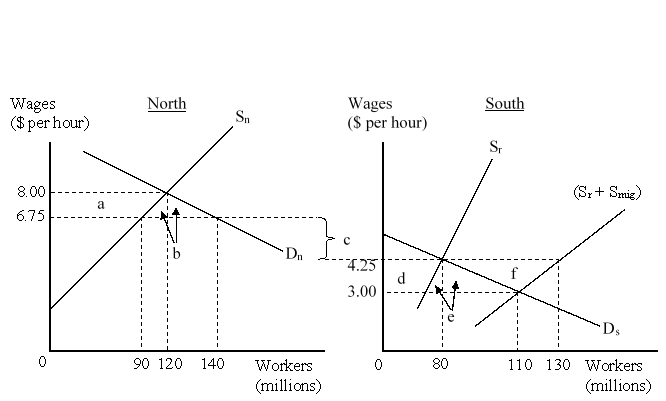 As a result of migration, the employers in North:
As a result of migration, the employers in North:
A)lose $131.25 million.
B)gain $31.25 million.
C)gain $162.5 million.
D)lose $100 million.
 As a result of migration, the employers in North:
As a result of migration, the employers in North:A)lose $131.25 million.
B)gain $31.25 million.
C)gain $162.5 million.
D)lose $100 million.

Unlock Deck
Unlock for access to all 60 flashcards in this deck.
Unlock Deck
k this deck
29
Which of the following groups are positively affected by foreign direct investment outflows?
A)The home country's labor unions
B)Tax payers in the home country
C)The home country's government
D)The owners of the multinationals
A)The home country's labor unions
B)Tax payers in the home country
C)The home country's government
D)The owners of the multinationals

Unlock Deck
Unlock for access to all 60 flashcards in this deck.
Unlock Deck
k this deck
30
Which of the following was among the policies that the Chinese government began to implement since 2006?
A)Engaging in "bidding wars" with other countries to attract FDI
B)Phasing out many of the tax incentives which were initially provided to the foreign firms
C)Reducing the restrictions on foreign acquisitions of Chinese publicly traded companies.
D)Emphasizing on the quantity of investments of inbound FDI
A)Engaging in "bidding wars" with other countries to attract FDI
B)Phasing out many of the tax incentives which were initially provided to the foreign firms
C)Reducing the restrictions on foreign acquisitions of Chinese publicly traded companies.
D)Emphasizing on the quantity of investments of inbound FDI

Unlock Deck
Unlock for access to all 60 flashcards in this deck.
Unlock Deck
k this deck
31
Which of the following is most likely to be an impact of FDI?
A)There may arise temporary unemployment in the home country.
B)The rental rate of capital declines in the home country.
C)The wage rate declines in the host countries.
D)Government revenue of the home country increases.
A)There may arise temporary unemployment in the home country.
B)The rental rate of capital declines in the home country.
C)The wage rate declines in the host countries.
D)Government revenue of the home country increases.

Unlock Deck
Unlock for access to all 60 flashcards in this deck.
Unlock Deck
k this deck
32
The figure given below represents the effects in the labor markets due to migration. Here the world has been divided into a high-income "North" (left panel) and a low-income "South" (right panel). Dn and Sn are the labor demand and the labor supply curves in North. Ds and (Sr + Smig) are the labor demand and pre-migration labor supply curves in South. Sr is the post-migration labor supply curve in South. The value c is the cost of migrating.  The world's net gain due to migration is represented by the area:
The world's net gain due to migration is represented by the area:
A)(a + b).
B)(e + f).
C)(a + f).
D)(b + f).
 The world's net gain due to migration is represented by the area:
The world's net gain due to migration is represented by the area:A)(a + b).
B)(e + f).
C)(a + f).
D)(b + f).

Unlock Deck
Unlock for access to all 60 flashcards in this deck.
Unlock Deck
k this deck
33
The figure given below represents the effects in the labor markets due to migration. Here the world has been divided into a high-income "North" (left panel) and a low-income "South" (right panel). Dn and Sn are the labor demand and the labor supply curves in North. Ds and (Sr + Smig) are the labor demand and pre-migration labor supply curves in South. Sr is the post-migration labor supply curve in South. The value c is the cost of migrating. 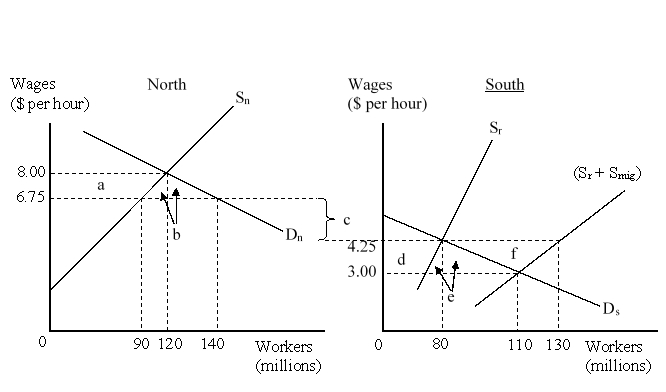 When migration is not allowed, workers in North earn _____ per hour and workers in South earn _____ per hour.
When migration is not allowed, workers in North earn _____ per hour and workers in South earn _____ per hour.
A)$6.75; $4.25
B)$8.00; $4.25
C)$6.75; $3.00
D)$8.00; $3.00
 When migration is not allowed, workers in North earn _____ per hour and workers in South earn _____ per hour.
When migration is not allowed, workers in North earn _____ per hour and workers in South earn _____ per hour.A)$6.75; $4.25
B)$8.00; $4.25
C)$6.75; $3.00
D)$8.00; $3.00

Unlock Deck
Unlock for access to all 60 flashcards in this deck.
Unlock Deck
k this deck
34
Which of the following groups are negatively affected by foreign direct investment flows?
A)The host country's workers
B)The home country's workers
C)The host country's government
D)The suppliers of inputs to the affiliates of foreign multinationals
A)The host country's workers
B)The home country's workers
C)The host country's government
D)The suppliers of inputs to the affiliates of foreign multinationals

Unlock Deck
Unlock for access to all 60 flashcards in this deck.
Unlock Deck
k this deck
35
The figure given below represents the effects in the labor markets due to migration. Here the world has been divided into a high-income "North" (left panel) and a low-income "South" (right panel). Dn and Sn are the labor demand and the labor supply curves in North. Ds and (Sr + Smig) are the labor demand and pre-migration labor supply curves in South. Sr is the post-migration labor supply curve in South. The value c is the cost of migrating. 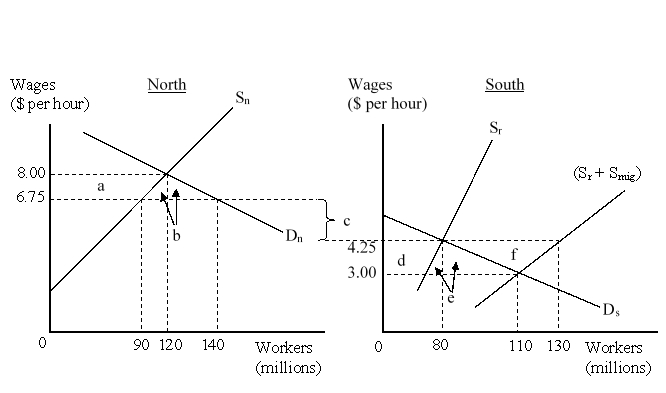 After migration of the workers, the workers in North earn _____ per hour and South workers earn _____ per hour.
After migration of the workers, the workers in North earn _____ per hour and South workers earn _____ per hour.
A)$6.75; $4.25
B)$8.00; $4.25
C)$6.75; $3.00
D)$8.00; $3.00
 After migration of the workers, the workers in North earn _____ per hour and South workers earn _____ per hour.
After migration of the workers, the workers in North earn _____ per hour and South workers earn _____ per hour.A)$6.75; $4.25
B)$8.00; $4.25
C)$6.75; $3.00
D)$8.00; $3.00

Unlock Deck
Unlock for access to all 60 flashcards in this deck.
Unlock Deck
k this deck
36
If movement of labor across countries is costless and painless, it can be expected that:
A)all the countries in the world will operate at the full employment level.
B)the wage rates in the countries will equalize over time.
C)the rate of unemployment will fall to zero in all the countries.
D)the GDP of the countries will equalize over time.
A)all the countries in the world will operate at the full employment level.
B)the wage rates in the countries will equalize over time.
C)the rate of unemployment will fall to zero in all the countries.
D)the GDP of the countries will equalize over time.

Unlock Deck
Unlock for access to all 60 flashcards in this deck.
Unlock Deck
k this deck
37
As some government spending is for true public goods in sending countries, the loss of future tax contributions is likely to be _____ the reduction in future government spending as people migrate from the country.
A)larger than
B)smaller than
C)equal to
D)independent of
A)larger than
B)smaller than
C)equal to
D)independent of

Unlock Deck
Unlock for access to all 60 flashcards in this deck.
Unlock Deck
k this deck
38
In the case in which foreign affiliates undertake the same kind of production as the parent firm, the affiliate _____ some trade in that product. The affiliate also _____ trade through better local marketing of other products produced by the multinational in other countries.
A)displaces; expands
B)expands, displaces
C)expands; expands
D)displaces; displaces
A)displaces; expands
B)expands, displaces
C)expands; expands
D)displaces; displaces

Unlock Deck
Unlock for access to all 60 flashcards in this deck.
Unlock Deck
k this deck
39
The figure given below represents the effects in the labor markets due to migration. Here the world has been divided into a high-income "North" (left panel) and a low-income "South" (right panel). Dn and Sn are the labor demand and the labor supply curves in North. Ds and (Sr + Smig) are the labor demand and pre-migration labor supply curves in South. Sr is the post-migration labor supply curve in South. The value c is the cost of migrating.  When migration between North and South is allowed, how many workers will choose to migrate to North?
When migration between North and South is allowed, how many workers will choose to migrate to North?
A)20 million
B)30 million
C)40 million
D)50 million
 When migration between North and South is allowed, how many workers will choose to migrate to North?
When migration between North and South is allowed, how many workers will choose to migrate to North?A)20 million
B)30 million
C)40 million
D)50 million

Unlock Deck
Unlock for access to all 60 flashcards in this deck.
Unlock Deck
k this deck
40
China's economic growth and emergence as a major exporter was assisted by:
A)opening the country to FDI.
B)restricting inflows of FDI.
C)the use of inward-oriented policies.
D)exploiting a comparative advantage in primary products.
A)opening the country to FDI.
B)restricting inflows of FDI.
C)the use of inward-oriented policies.
D)exploiting a comparative advantage in primary products.

Unlock Deck
Unlock for access to all 60 flashcards in this deck.
Unlock Deck
k this deck
41
Both external and internal factors affect the operation of an MNE. External factors are outside the immediate control of the firm while internal factors are within the control of the firm. Give examples for both and discuss how they would affect the operations of the multinational enterprise.

Unlock Deck
Unlock for access to all 60 flashcards in this deck.
Unlock Deck
k this deck
42
FDI outflows have a positive impact on workers in the home country.

Unlock Deck
Unlock for access to all 60 flashcards in this deck.
Unlock Deck
k this deck
43
The host country has more reasons to restrict FDI than does the home country.

Unlock Deck
Unlock for access to all 60 flashcards in this deck.
Unlock Deck
k this deck
44
Should receiving countries ban all forms of immigration because non-immigrant workers in the receiving country are hurt by immigration? Discuss.

Unlock Deck
Unlock for access to all 60 flashcards in this deck.
Unlock Deck
k this deck
45
In 2007-2011 China was the largest recipient of direct investment flows in the world.

Unlock Deck
Unlock for access to all 60 flashcards in this deck.
Unlock Deck
k this deck
46
Sending countries that do not receive much in the way of remittances probably gain well-being, but those receive substantial remittances probably lose well-being.

Unlock Deck
Unlock for access to all 60 flashcards in this deck.
Unlock Deck
k this deck
47
It is easier to transfer capital from one country to another using FDI than to use international portfolio investment.

Unlock Deck
Unlock for access to all 60 flashcards in this deck.
Unlock Deck
k this deck
48
The existence of migration costs implies that factor-price-equalization in the labor market is less likely.

Unlock Deck
Unlock for access to all 60 flashcards in this deck.
Unlock Deck
k this deck
49
Trade among parent and affiliates engaged in different stages of production shows that foreign direct investment and trade can sometimes be complements.

Unlock Deck
Unlock for access to all 60 flashcards in this deck.
Unlock Deck
k this deck
50
Foreign Direct Investment is used for all foreign securities investments that do not involve management control.

Unlock Deck
Unlock for access to all 60 flashcards in this deck.
Unlock Deck
k this deck
51
What factors should be considered in determining whether a firm should sell to buyers in a foreign country by exporting from its home country or by setting up local production in the foreign country to produce the products that are sold to foreign consumers? When identifying these factors, clearly explain how and why they push the decision toward one or the other of the two available choices.

Unlock Deck
Unlock for access to all 60 flashcards in this deck.
Unlock Deck
k this deck
52
Political risk is the possibility that the government of the host country will alter its policies in ways that harm the multinational enterprise.

Unlock Deck
Unlock for access to all 60 flashcards in this deck.
Unlock Deck
k this deck
53
How do the characteristics of immigrants influence the effects of immigration on the receiving country? What are the implications for receiving country government policy toward immigration?

Unlock Deck
Unlock for access to all 60 flashcards in this deck.
Unlock Deck
k this deck
54
The changes in China's FDI policy since 2006 are likely to shift manufacturing FDI away from unskilled-labor-intensive production like toys.

Unlock Deck
Unlock for access to all 60 flashcards in this deck.
Unlock Deck
k this deck
55
Countries that grow the fastest are those that adopt inward-oriented policies toward trade and foreign direct investment.

Unlock Deck
Unlock for access to all 60 flashcards in this deck.
Unlock Deck
k this deck
56
Suppose a firm wants to expand sales of its product into a foreign country. Should the firm license local firms in the foreign country to use its technologies to produce the product or should it set up a foreign operation that it owns and controls? What factors should the firm consider in taking the decision? When identifying these factors, clearly explain how and why they push the decision toward one or the other of the two available choices.

Unlock Deck
Unlock for access to all 60 flashcards in this deck.
Unlock Deck
k this deck
57
In the past three decades many developing countries have shifted away from restricting FDI inflows to encouraging them.

Unlock Deck
Unlock for access to all 60 flashcards in this deck.
Unlock Deck
k this deck
58
Analysis of the labor market shows that a receiving country loses economic well-being from migration.

Unlock Deck
Unlock for access to all 60 flashcards in this deck.
Unlock Deck
k this deck
59
Historically, the U.S. firms have shown less of a preference for FDI and management control than have firms from other investing countries.

Unlock Deck
Unlock for access to all 60 flashcards in this deck.
Unlock Deck
k this deck
60
A multinational enterprise produces a component in the United Kingdom, where the corporate income tax rate is 60 percent. It produces its final product in Taiwan, where the corporate income tax rate is 25 percent. The cost of the component produced in the United Kingdom is $4 per unit. The components can be shipped to Taiwan at almost no cost, and there is no tariff on the component when it is imported into Taiwan. Each unit of the final product requires one unit of the component. Other production costs in Taiwan to complete the final product are $14 per unit. The final product price, when it is sold by the Taiwan affiliate to outside buyers, is $20 per unit. If the goal of the multinational enterprise is to maximize its global after tax profit, which of the following three choices should the controller of the multinational enterprise favor? Why?
a.Charge a transfer price of $4 per unit
b.Charge a transfer price of $5 per unit
c.Charge a transfer price of $6 per unit
a.Charge a transfer price of $4 per unit
b.Charge a transfer price of $5 per unit
c.Charge a transfer price of $6 per unit

Unlock Deck
Unlock for access to all 60 flashcards in this deck.
Unlock Deck
k this deck



